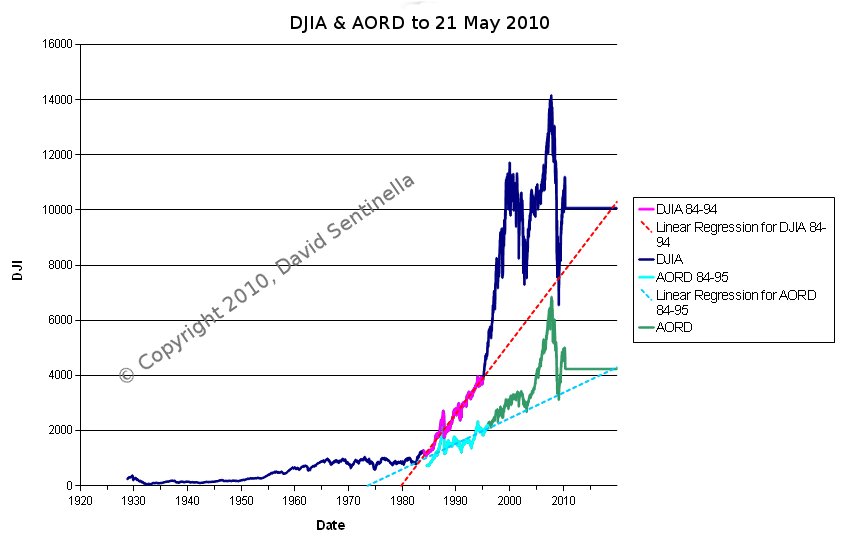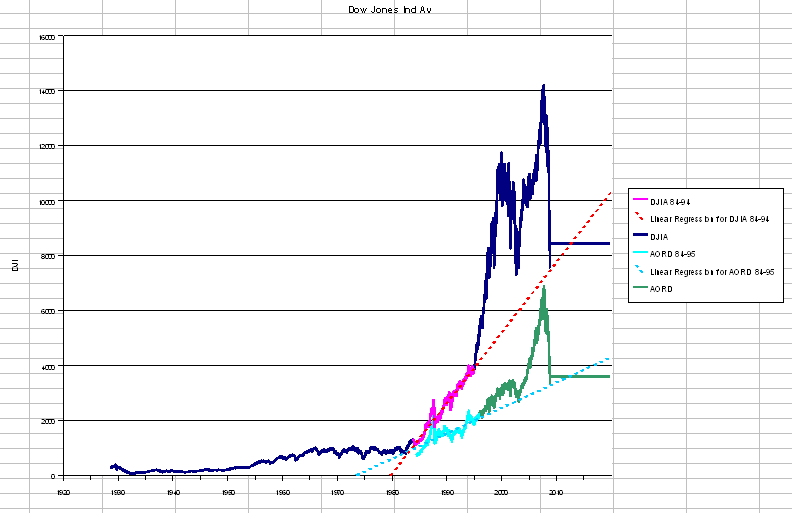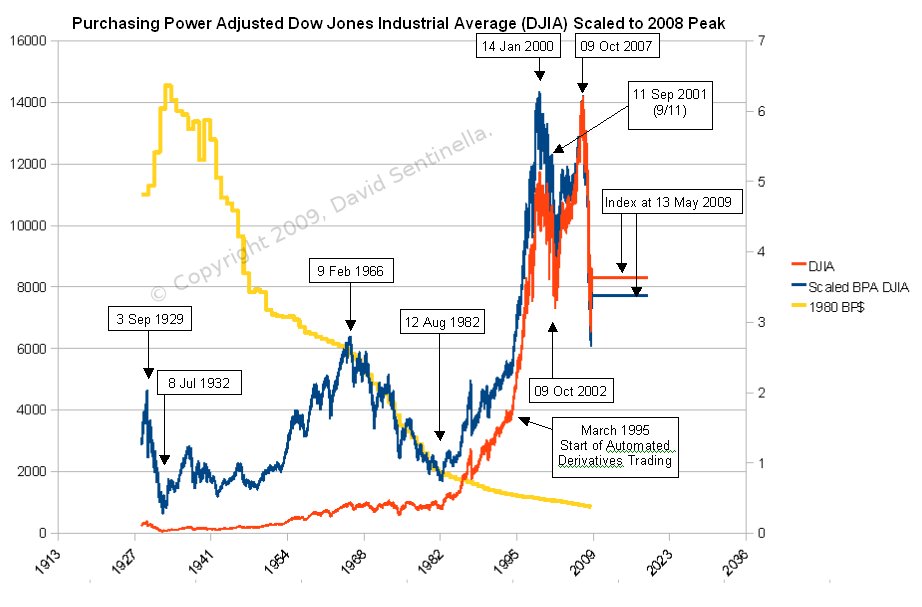David's Rantings (aka Blog)
You need to register, and be logged on, to write comments here.
DJIA & AORD Chart as at 21 May 2010

Post GFC Crisis?
An Idea for a new Australian Flag
I appreciate this is an appropriation of the Australian Aboriginal
Flag, and, of course, would be subject to the approval of Aboriginal
people and groups. It's
a dilemma. If included or left out, there will be criticism. If
Australia has two flags, can we still achieve true reconciliation?
I rather like the FlagOz design but suggest this modification:
ETS The Sense of The Greens Position.
Amid the jostling for the control of the Liberal Party in Australia, the conservatives criticised the ETS as too costly, yet could not see that what the Greens were proposing was economically and environmentally superior.
Current Stock Market Position (The flat line section is current index value)
Looking at this you'd have to ask; "what happened in 1995?"
This chart compares the Dow Jones Industrial Average to the All Ordinaries. This dotted line is the extrapolation of the 84 to 94 linear regression. This chart shows a major change around 1984 and something much more profound around 1995.

I think what we are seeing here relates primarily to the nature of production as it, in turn, relates to our available technologies and how we use them. There can be no doubt that steam and steel transformed humanity in the early part of the industrial revolution. The internal combustion engine and the ease of transport that it brought, transformed the early part of the twentieth century. Electronics then became the most significant technology, and evolving from it came computer technology.
I suggest that the period from 1984 to 1995 marked a change in our production techniques from primarily mechanical and electro-mechanical, to primarily computer driven production. Anyone who worked in design-related industries will remember a transition from paper based data, through microfiche, to electronic forms. The pace of design accelerated, an so did the pace and sophistication of manufacture.
The acceleration of the world economy from 1995 has largely been powered by Asian economies, and a shift from western production to Asian production. The rationale has always been "cost". Western nations thought that they had some special hold on "intellectual property" and that would leave them, somehow, in control. Quite naturally, Asian economies embraced the technologies brought to them by western manufacturers and, in a very short time, were producing their own advances.
All of this production, all of this massive boom in goods was not without cost: resources and transport being pivotal.
It is my belief that it was around 1995 that the computerisation of marketing exploded around the world, suddenly everyone could advertise and promote very cheaply. Products we barely understood a few years before, were suddenly essential. The drain on resources and energy sky-rocketed.
Added May 2009:
In this chart, the Dow Jones Industrial Average is adjusted to1980 based Purchasing Power (Buying Power) dollars and scaled the October 2007 stock market peak. The yellow line is the 1980 dollar equivalent over time. Here we see a boom and bust between 1945 and 1982 that is "invisible" on a normal DJIA chart.
DJIA & AORD Chart as at 21 May 2010

Post GFC Crisis?
An Idea for a new Australian Flag
 New Australian National Flag Idea by David Sentinella |
 New Australian Air Force Flag Idea by David Sentinella |
 New Australian Merchant Flag Idea by David Sentinella |
 New Australian Naval Ensign Idea by David Sentinella |
I rather like the FlagOz design but suggest this modification:
 |
ETS The Sense of The Greens Position.
Amid the jostling for the control of the Liberal Party in Australia, the conservatives criticised the ETS as too costly, yet could not see that what the Greens were proposing was economically and environmentally superior.
Current Stock Market Position (The flat line section is current index value)
Looking at this you'd have to ask; "what happened in 1995?"
This chart compares the Dow Jones Industrial Average to the All Ordinaries. This dotted line is the extrapolation of the 84 to 94 linear regression. This chart shows a major change around 1984 and something much more profound around 1995.

I think what we are seeing here relates primarily to the nature of production as it, in turn, relates to our available technologies and how we use them. There can be no doubt that steam and steel transformed humanity in the early part of the industrial revolution. The internal combustion engine and the ease of transport that it brought, transformed the early part of the twentieth century. Electronics then became the most significant technology, and evolving from it came computer technology.
I suggest that the period from 1984 to 1995 marked a change in our production techniques from primarily mechanical and electro-mechanical, to primarily computer driven production. Anyone who worked in design-related industries will remember a transition from paper based data, through microfiche, to electronic forms. The pace of design accelerated, an so did the pace and sophistication of manufacture.
The acceleration of the world economy from 1995 has largely been powered by Asian economies, and a shift from western production to Asian production. The rationale has always been "cost". Western nations thought that they had some special hold on "intellectual property" and that would leave them, somehow, in control. Quite naturally, Asian economies embraced the technologies brought to them by western manufacturers and, in a very short time, were producing their own advances.
All of this production, all of this massive boom in goods was not without cost: resources and transport being pivotal.
It is my belief that it was around 1995 that the computerisation of marketing exploded around the world, suddenly everyone could advertise and promote very cheaply. Products we barely understood a few years before, were suddenly essential. The drain on resources and energy sky-rocketed.
Added May 2009:
In this chart, the Dow Jones Industrial Average is adjusted to1980 based Purchasing Power (Buying Power) dollars and scaled the October 2007 stock market peak. The yellow line is the 1980 dollar equivalent over time. Here we see a boom and bust between 1945 and 1982 that is "invisible" on a normal DJIA chart.


 TechDev Services
TechDev Services
Comments
Carbon emission reduction
Here is my reasoning:
Total Atmospheric Mass = 5 x 1015 tons
CO2 Concentration (2009) = 393 ppm
Total CO2 in atmosphere (2009) = 1,915 Gt (1.915 x 1012 tons)
Total Annual Anthropogenic CO2 Emissions (2009) = 28.43 Gt
Total Annual Anthropogenic CO2 Emissions as a % of Atmospheric CO2 (2009) = 1.48%
Approximate year when emissions where half of 2009 = 1972
CO2 Concentration (1972) = 325 ppm
Total CO2 in atmosphere (1972) = 1,625 Gt
37 year difference in CO2 in atmosphere (1972-2009) = 290 Gt
Using a summation of Anthropogenic CO2 Emissions (1972-2009):
Total Anthropogenic CO2 Emissions (1972-2009) = 789 Gt
Annual Average Anthropogenic CO2 Emissions needed to account for the increase in atmospheric CO2 Concentration (1972-2009) = 7.84 Gt or 27.57% of current CO2 Emissions
Annual anthropogenic emissions are currently running at 1.48% of total atmospheric CO2. At current rates, if it all stayed there that would be a doubling in 67 years.
Anthropogenic emissions were about 50% less in about 1972 when the CO2 concentration was about 325 ppm. The last doubling of emissions took 37 years. During that time atmospheric CO2 has elevated by 290 Gigatons while the total anthropogenic emissions during that period were 789 Gigatons. On that basis it would appear we need to reduce global CO2 emissions by about 7.8 Gigatons per year, from current levels, for there to be a real chance of turning it around. That's a little over 25% (27.5% by my calculations).
That said, it may not be quite as bad as that because CO2 is not the whole picture.
There is no doubt that we need to re-think everything we do to live in a 25% reduced emission economy.
The following is achievable:
1. Reduction of Consumption
2. Population Stabilisation and Reduction
3. Relocalisation of work and production
4. Solar and Wind at every possible generation point
5. Move to a hydrogen and solar based transport system
6. Ensure that Coal and Oil use competes on an equal basis with low emission energy sources.
7. Reafforestation.
and more.
In my mind, nuclear is not an acceptable part of the solution.
The Morality of Complexity
I recently had to deal with the hospital system where I was again confronted by the bureaucratic burden of modern life. This seemed to tie into other ideas I have been pondering and the the ideas conveyed by following people: Slavoj Žižek, Jeffery Friedman, Antony Jay and Mark Rowlands.
From Mark Rowlands, Professor of Philosophy at the University of Miami, if you follow his reasoning, we get the idea that much of what is labelled "moral" is code for "power" and "power" is often propped up by deceit. In Rowlands' words:
"So what seems to be about morality, a theory it seems to be explaining morality, you dig a little deeper, what do you find? Power. It's all about power."
"... then I think at the core of our idea of morality, what we find are concepts such as power and deception; that is at the basis of human morality."
"At very least, you refrain from sticking a knife in my back and I'll refrain from sticking one in yours. So that's the sort of foundation of morality, a system of agreements we enter into to facilitate our interactions with each other. So we accept certain limitations on our freedom, no sticking daggers in people's back[s], if they will accept other limitations."
We end up with a social contract, but the problem with social contracts has to do with size, the larger the group, the more rigid the contract, the less likely the we are get a reasonable outcome for members of the group.
This ties in with another idea that I have talking about - optimum village size, and by village, I mean suburban neighbourhood or any other structure it which people live closeby. It seems that 500 is a good size for a village but more of that later.
Prize attraction and risk aversion
Some time ago I started looking into understanding human behaviour when faced with risk choices. These are the forces that drive gambling, the stock market, insurance, business, engineering and relationships. I've discovered this is an active area of research.
In the journal of 'Judgement and Decision Making' vol. 1, no. 2, November 2006, pp. 153-158, entitled: "The rich get richer and the poor get poorer: On risk aversion in behavioural decision-making", the authors conclude '... that people who "have" make more risk-averse decisions, while the "have-nots" make more risk-seeking decisions.'
That said, I wanted to develop an objective measure to compare any pair of risk scenarios. The most common examples are gambling scenarios. The parameters are:
Prize value (P),
Probability of winning the prize (Pp), and
Wager value (W).
It is obvious to say that increasing prize value and probability of winning a prize, and decreasing wager value all increase prize attraction.
I put together something I call a "better bet index" (BBI) and it is simply
BBI= P*Pp/W
or, where there are multiple outcomes with multiple probabilities
BBI= (P1*P1p/W + P2*P2p/W + .....)
So, if you had a 1/2000 chance of winning $1000 for $1 wager, the BBI is 0.5
and if wager were $2 the BBI would be 0.25.
Any fair non-profit lottery would have a BBI of 1.
A simple coin toss "double or nothing" is obviously a BBI of 1.
Interestingly the latest OzLotto Jackpot of $90 million represents a BBI of 2.23 and a jackpot of about of about $35 million represents a BBI of 1 (equivalent to a break even lottery). This, of course, does not alter the probability of winning, it's just that the accumulated prize reaches a point where BBI exceeds that of a fair, non-profit bet.
My own anecdotal research suggests that a BBI greater than 1 is the tipping point for most people - most people with reasonable logic or maths have a natural feel for this.
With this framework in place, I'm considering the proposition in the journal article quoted above, namely: "the rich get richer and poor get poorer". It would be wrong to suggest that the rich are completely risk averse and the poor completely risk inclined, and it is more interesting to discover where the tipping point between risk averse and risk inclined exists.
The journal article further concludes "... prior losses put the subject in the domain of losses and prior gains have the opposite effect. " I think that means "think positively - no matter what".
Classical Guitar Society Sydney Performance 30 May 2009
A great night again at the Independent theatre last night. The CGS put together a marvellous program last night which should act as a model for future successful nights. Performances by two exclusive private school guitar ensembles launched a night of tremendous variety. We were treated a rare lute solo performance that kept the large audience spellbound.
The CGS Ensemble came of age last night and established itself as a unique entity in Sydney's rich tapestry of musical enthusiasm and talent. One had the feeling that the Ensemble is now ready to grow and and prosper, and that it will endure.
Alternative Energy Sources and World Energy
I've been thinking about the energy component of the world economy. Global GDP for 2008 about US$70.65 trillion (PPP) and the total energy consumed was about 471 EJ. If we take a figure like $15/GJ, that's US$7.085 trillion - making energy about 10% of the world economy. About 37% of energy is used by industrial users (manufacturing, agriculture, mining, and construction). About 20% of energy is used personal and commercial transportation consumes.
It seems reasonable to say that 50% the cost of the products we buy is an energy cost component.
I think there is hope in these numbers, for the energy component of the world economy, as a proportion, continues to fall. The consensus of scientific opinion is therefore correct in concluding that climate change relates almost entirely to energy use, and by dealing with energy we can arrest and reverse climate change.
I am pleased to read today that 13 major manufacturers are poised to produce Battery Electric Vehicles, and the hydrogen economy is also advancing rapidly. I recognise that both of these technologies will increase the demand for electricity but will reduce overall energy demand.
Our fundamental sources do need to change. Solar is the clear choice. I have already calculated that photovoltaics on 21% of Australian domestic roofs would easily provide enough energy make all homes self-sufficient. I don't mean that we disconnect homes from the grid; far from it, the grid is crucial to energy re-engineering.
Industrial energy should rely on large scale solar. My favourite for Australian conditions is Enviromission, because it provides base-load power and requires little or no water. Photovoltaics on commercial and industrial buildings will also help. Direct hydrogen photochemical hydrolysis should become a significant technology.
That said, the biggest savings we can make are in energy efficiency, re-localisation and population limitation through education.
Nuccio D'Angelo
Last night (16 Jan 2009) I saw Nuccio D'Angelo play at the CGSS (Classical Guitar Society, Sydney) summer school concert. Yet another wonderful experience courtesy of the CGSS. Nuccio strikes me as truly academic in his exploration of musical forms, his demonstration of the structural elements of various musical influences, together with his delightful narrative, opened a window of understanding into the essential connection between humanity and music. I don't mean to say that the music is academic, quite the opposite, Nuccio's performance is natural, fluid and evocative. Listening to his interpretations, I could feel that Nuccio had systematically worked through hundreds of variations and juxtapositions and he had distilled the expressive forms and stylistic methods that suited his unique musical message.
It is so refreshing to see musicians talk about their journey during their concerts and then to feel their journey through the music.
I look forward to seeing and hearing the Guitar Heroes interview when it reaches their website (http://www.guitarheroes.com.au).
also see:
http://www.nucciodangelo.it/
Emission Targets
I was shocked at the announcement today (15-Dec-2008) of Australia's proposed C02 targets - 5% will barely cover the cost of administering the scheme and do little to stimulate alternative technologies.
If the the Rudd government is serious about climate change, and it says it will increase targets if the rest of the world also does, then, at least, let it quantify what that means. Such a promise might take the form of an equation - something like:
[Australia's Target x Australia's Net Emission/Global Emission] + lead factor =
∑[ (Country's target) x (Country's Net Emission)/Global Emission]
In this way Australia would always match and exceed the average every other country's contribution.
Greek Riots
Anyone who watches the riots in Greece would have to wonder why the death of one person could spark such widespread anger.
Reported in the Irish Times:
"Protests were reported in more than 10 cities across the nation of 11 million people, including the northern city of Thessaloniki and the tourist islands of Crete and Corfu."
My suspicions were aroused when I saw a report of a fashion store owner in Athens vowing revenge against the rioters, her face expressing some kind perverse pleasure in the notion. In another report, the editor of a Greek newspaper in Australia skillfully and tactfully explained that Greek Australians were largely conservative and would naturally express opposition to the issues cited by the rioters. He did not spell out the nature of the economic and social disenfranchisement which seems to be the underlying cause, but merely hinted at it. It is as if he was afraid to do so.
In a word of mouth account related to me, it seems the current Greek government has changed property laws that have effectively concentrated property ownership in the hands of the powerful and wealthy. It seems Greece has returned to the bad old days of dictatorship.
The Problem with Bio-Fuels
Yesterday (7-Dec-2008) I had the opportunity to discuss bio-fuels and, through weighing up the issues, it strengthened my resolve to support the preservation and rehabilitation of arable land. Despite bio-fuel production being a renewable resource, the obscenity of diverting food crops to motor vehicles should exclude such feed stocks from any long term solution. Is crop stubble or wood "waste" any better as a feed stock? In my view, these would be better used form improving the organic matter content of soils. Now there is the idea of absorbing CO2 using algae or bacteria and harvesting these micro-organisms to produce bio-diesel. This has some merit, but we would need vast sunlit ponds to achieve any significant conversion.
In the end, it is my belief that hydrogen will become the portable fuel of the future because it functions outside the carbon cycle all together.
Wulfin Lieske
Wulfin Lieske played at the Independent Theatre last night (29 Nov 2008) - what a marvellous performance. His mastery was matched by a deep understanding of the music and culture that surrounded each piece - he played a 19th century first half of the program followed by an Australian dominated second half. His Sculthorpe was the best I have ever heard. Congratulations to Sydney's Classical Guitar Society for giving us this special moment to experience Wulfin's exceptional talent.
Musicians, at all levels, can learn a lot from Wulfin's style of performance - he connects with his audience in a way that invites the audience into a conversation.
Update:
I was very fortunate to have met Wulfin at a barbecue the day after the concert and it is clear that his personal philosophy and keen intellect enriches his musical expression.
Open Source Software
The position of the Open Source Software movement/community in relation to the current economic crisis is worth exploring. Many of my friends and relatives who are on the front line of education have observed an increase in enrolments and one would imagine that the total cost of education will consequently increase due to greater demand on services, and the cost of software for students will be significant. It will be interesting to see how IT roll-outs will proceed - will Microsoft and Apple try to dominate software distribution by offering massive education discounts in the expectation that students will influence their employers and workplaces when they graduate? Perhaps this government will take a more enlightened position and see not just the cost benefit, but the benefit of having the processes open for wider scrutiny and subsequent shared invention and improvement.
Global Financial Crisis